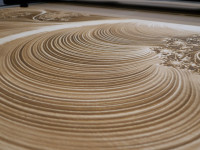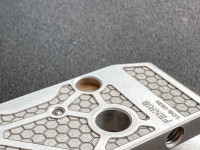Laser engraving and laser cutting in prototyping and toolmaking
Efficiency and precision for innovative solutions
Laser engraving and laser cutting are two of the most advanced technologies that play an essential role in today's industry. Especially in prototyping and toolmaking, these processes offer a multitude of advantages that lead to greater efficiency, shorter development times, precision and cost savings. By integrating laser technologies, companies can develop innovative solutions and optimize their production processes.
Laser technology in prototyping
Product development requires speed - from the first draft to the functional prototype. This is where laser technology excels:
Maximum design freedom:
Laser processing enables intricate cuts and engravings without tool changes or time-consuming retooling. Geometries can be taken directly from CAD data and transferred to the material.
Non-contact processing:
As there is no physical contact with the workpiece during laser cutting, sensitive materials are protected. There are no deformations or mechanical stresses - a clear advantage over conventional manufacturing processes.
High repeat accuracy:
Ideal for prototypes in small series. The high reproducibility ensures that every single prototype meets exactly the same quality standard.
Variety of materials:
From metals such as aluminum or stainless steel to plastics, wood and technical textiles - modern laser systems process a wide range of materials efficiently and precisely.
Laser engraving is a process in which a laser beam is used to mark or label materials. In prototyping, laser engraving is often used to mark prototypes with logos, serial numbers, text or other important information. This enables fast and precise marking, which is crucial for identification and quality control.
Advantages of laser engraving in prototyping
- High precision: Laser engraving offers exceptionally high accuracy, making it possible to engrave the finest details on prototypes.
- Flexibility: Laser engraving can be applied to various materials such as metal, plastic, wood and glass.
- Efficiency: Engraving is fast and requires no additional tools, which reduces production time.
- Durability: The engravings are resistant and retain their quality over a long period of time
Use in toolmaking: Customized work with the laser
Toolmaking places the highest demands on precision and durability. Laser engraving and cutting provide support here:
Engraving of mold inserts and tool components:
Whether serial numbers, register marks or complex markings - laser engraving is durable, abrasion-resistant and can also be carried out on hardened surfaces.
Production of individual tool inserts:
Customized inserts or fixtures can be produced quickly and precisely using laser cutting - without long lead times.
Optimization of the process chain:
The integration of laser technology into existing manufacturing processes reduces manual work steps, lowers the error rate and increases process reliability.
Laser cutting in toolmaking
Laser cutting is a process in which a laser beam is used to cut materials. In toolmaking, laser cutting is used to create precise and complex shapes from various materials. This technology enables the production of tools with high precision and low material waste.
Advantages of laser cutting in toolmaking
High precision: Laser cutting enables extremely precise cuts, which is particularly advantageous when manufacturing complex tools.
Versatility: The process can be applied to a wide range of materials such as metal, plastic and wood.
Clean cuts: The cut edges are smooth and require no additional finishing.
Less material waste: Laser cutting minimizes material loss and optimizes material usage.
Integration of laser technologies in production
The integration of laser engraving and laser cutting into the production process offers numerous advantages. Companies can use these technologies to optimize their production processes and improve the quality of their products. In addition, laser technologies enable faster and more cost-effective production of prototypes and tools, which increases innovative capacity and competitiveness.
Application examples
- Automotive industry: Production of precise tools and prototypes for vehicle components.
- Electronics industry: marking of prototypes and production of complex components.
- Medical technology: production of precision tools and devices for medical applications.
- Aerospace: production of prototypes and tools for aerospace technology.
Economic advantages through the use of laser systems
In addition to technical aspects, laser technology in prototyping and toolmaking also scores in economic terms:
- Reduction of time-to-market through accelerated product development
- Minimization of scrap material thanks to precise machining
- Cost savings due to elimination of tool wear and reduced reworking effort
- Flexibility in production, ideal for changing projects and product cycles
Laser engraving and laser cutting are indispensable technologies in modern prototyping and toolmaking. Thanks to their high precision, flexibility and efficiency, they offer numerous advantages that contribute to the optimization of production processes. Companies that integrate these technologies into their development and manufacturing processes can develop innovative solutions and increase their competitiveness on the market.
FAQ: Frequently asked questions about laser engraving and laser cutting in prototyping and toolmaking
Which materials can be processed with lasers in prototyping?
Modern laser systems cut and engrave a wide range of materials - including metals, plastics, wood, acrylic, textiles, ceramics and more. The choice of laser type (e.g. CO₂ or fiber laser) depends on the material.
How precise is laser cutting compared to other processes?
Laser cutting enables cutting widths in the tenth of a millimeter range and is therefore ideal for complex geometries and delicate structures. Contactless processing means there is no mechanical stress in the material.
Is it worth using a laser system for individual items or small series?
Laser technology really comes into its own with prototypes and small batches: No tool costs, short set-up times, fast implementation - this makes it particularly economical in early development phases.
Can engravings also be realized on hardened or coated tool parts?
Yes, fiber lasers enable high-precision engraving even on hardened metals or coated surfaces. The markings are permanent, abrasion-resistant and particularly high-contrast.



